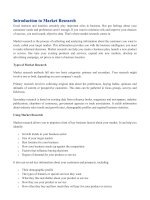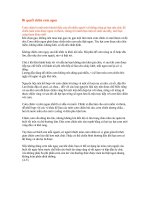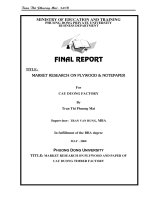Com MARKET RESEARCH 1
Bạn đang xem bản rút gọn của tài liệu. Xem và tải ngay bản đầy đủ của tài liệu tại đây (73.45 KB, 4 trang )
Lac Hong University
Đỗ Thị Lan Đài
Market Research and Step-by-Step Approach to
Market Research
To successfully export your product, you should examine foreign markets through
research. The purpose is to identify marketing opportunities and constraints abroad, as
well as to identify prospective buyers and customers.
Market research encompasses all methods that a company can use to determine which
foreign markets have the best potential for its products. Results of this research inform
the firm of: the largest markets for its product, the fastest growing markets, market trends
and outlook, market conditions and practices, and competitive firms and products.
Your firm may begin to export without conducting any market research if it receives
unsolicited orders from abroad. Although this type of selling is valuable, the company
may discover even more promising markets by conducting a systematic search. If your
firm opts to export indirectly by using an intermediary such as an Export Management
Company (EMC) or Export Trading Company (ETC), you may wish to select markets to
enter before selecting the intermediary. Because many intermediaries such as EMCs and
ETCs have strengths in certain markets, it is valuable to select the intermediary after
deciding on markets to enter. You may also want to do market research if you export
indirectly.
A firm may research a market by using either primary or secondary data resources. In
conducting primary market research, a company collects data directly from the foreign
English in Foreign Trade
1
Lac Hong University
Đỗ Thị Lan Đài
marketplace through interviews, surveys, and other direct contact with representatives
and potential buyers. Primary market research has the advantage of being tailored to the
company's needs and provides answers to specific questions, but the collection of such
data is time-consuming and expensive.
When conducting secondary market research, a company collects data from various
sources, such as trade statistics for a country or a product. Working with secondary
sources is less expensive and helps the company focus its marketing efforts. Although
secondary data sources are critical to market research, they do have limitations. The most
recent statistics for some countries may be more than two years old. Moreover, the data
may be too broad to be of much value to a company. Statistics may also be distorted by
incomplete data-gathering techniques. Finally, statistics for services are often
unavailable. Yet, even with these limitations, secondary research is a valuable and
relatively easy first step for a company to take. It may be the only step needed if the
company decides to export indirectly, since the intermediary firm may have advanced
research capabilities.
A.
Step-by-Step Approach to Market Research
Your company may find the following approach useful. It involves screening potential
markets, assessing the targeted markets, and drawing conclusions.
A. Screen Potential Markets
English in Foreign Trade
2
Lac Hong University
Đỗ Thị Lan Đài
Step 1. Obtain export statistics that indicate product exports to various countries.
Published export statistics provide a reliable indicator of where U.S. exports are
currently being shipped.
Step 2. Identify five to ten large and fast-growing markets for the firm's product.
Look at them over the past three to five years. Has market growth been consistent
year to year? Did import growth occur even during periods of economic
recession? If not, did growth resume with economic recovery?
Step 3. Identify some smaller but fast-emerging markets that may provide groundfloor opportunities. If the market is just beginning to open up, there may be fewer
competitors than in established markets. Growth rates should be substantially
higher in these countries to qualify as up-and-coming markets, given the lower
starting point.
Step 4. Target three to five of the most statistically promising markets for further
assessment.
B.
Assess Targeted Markets
Step 1. Examine trends for company products as well as related products, that
could influence demand. Calculate overall consumption of the product and the
amount accounted for by imports.
Step 2. Ascertain the sources of competition, including the extent of domestic
industry production and the major foreign countries the firm is competing against
in each targeted market by using ISAs and competitive assessments.
English in Foreign Trade
3
Lac Hong University
Đỗ Thị Lan Đài
Step 3. Analyze factors affecting marketing and use of the product in each market,
such as end-user sectors, channels of distribution, cultural idiosyncrasies, and
business practices.
Step 4. Identify any foreign barriers (tariff or nontariff) for the product being
imported into the country. Identify any U.S. barriers (such as export controls) that
affect exports to the country.
Step 5. Identify any U.S. or foreign government incentives that promote exporting
of your particular product or service.
C.
Draw Conclusions
After analyzing the data, the company may conclude that its marketing resources would
be applied more effectively to a few countries. In general, if the company is new to
exporting, then efforts should be directed to fewer than ten markets. Exporting to one or
two countries will allow the company to focus its resources without jeopardizing its
domestic sales efforts. The company's internal resources should determine its level of
effort.
English in Foreign Trade
4








![[Kinh Tế Học] Market Research - Nghiên cứu thị trường Phần 9 potx](https://media.store123doc.com/images/document/2014_07/28/medium_jwa1406510426.jpg)
![[Kinh Tế Học] Market Research - Nghiên cứu thị trường Phần 8 pdf](https://media.store123doc.com/images/document/2014_07/28/medium_xzb1406510426.jpg)